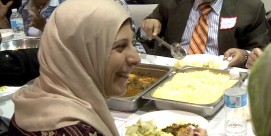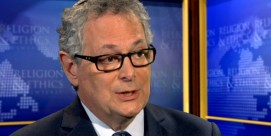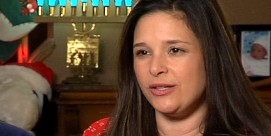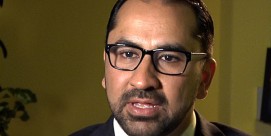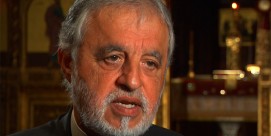In This Episode << SLIDE LEFT TO SEE ADDITIONAL SEGMENTS
Gary Laderman Extended Interview
Read excerpts from Jeff Sheler’s interview with Emory University religion professor Gary Laderman:
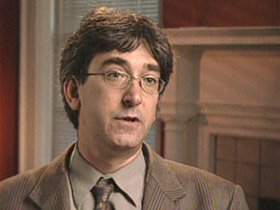
On the accommodations of new religious groups to the wider American culture:
That is a fundamental part of the story of American religious history. Religious groups that have come from different parts of the world and that are indigenous to American society generally have to make accommodations to the larger, mainstream American culture. The Muslims in Lawrenceville, Georgia are no different in many respects. Part of what they will have to do is adjust, adapt traditions to local and national laws and culture. It can be difficult to make these kinds of adjustments. And it can lead to fracturing within different religious traditions. Some people will interpret these kinds of changes in more fundamental ways. Others may take a more liberal approach and make the necessary adjustments to fit into the society they live in.
On pluralism and diversity:
Religious pluralism is a two-way street. Religious diversity is a two-way street. Both the mainstream culture and the religions on the margin will be impacted by just living together — just by proximity, by sharing the same culture. The Muslim groups are going to make their adjustments so that they can fit in; but the Christian groups will have to modify their stance about religious toleration, about religious openness to new people in the community. And it generally also leads to many efforts to educate the public, so they will learn more about Islam than probably they ever thought or imagined they would.
On going beyond mere tolerance:
Religious pluralism as it exists today, I think, is unprecedented. It’s really a new kind of social situation and social reality. So we don’t exactly know how Americans are going to live with this kind of religious pluralism, with this kind of religious diversity. Unfortunately, American religious history is full of violence and persecution and discrimination against outside religious groups. But, again, I think this is a new phase of American religious history. The kind of pluralism we’re seeing is unheard of, and we don’t know what the response is going to be. The new reality of religious pluralism in America — it’s going to take a while for that to settle in and for the people who have been there and who are part of the mainstream religious culture to adjust to a new presence, especially in [the] public arena, where the voices of outside religious groups, non-Christian religious groups, are becoming increasingly vocal.
On the future:
The long term is difficult to predict. Based on the past, you can see that certain more fundamental groups within Christian society have reacted fairly strongly and negatively [to religious diversity]. But that’s not the only story for Christians. A big part of American religious history is cooperation, openness, adjustment, change to new kinds of religious situations and realities. My own optimistic sense is that it’s promising. People will learn to live together, but that doesn’t exclude the fact that there’s likely to be more extreme reaction. The recent resolution by the Southern Baptist[s] to proselytize Hindus, for example, as a primary goal in their missionary activity — I think that’s an extreme reaction, and that doesn’t sit well with many people who want to celebrate American religious freedom… it’s hard to predict, but there are certainly groups that want to maintain a Christian predominance in culture and feel threatened by these new groups. I think for most religious groups there is going to be some level of adjustment to the new religious reality of multiple religious communities existing in one metropolitan area. It will lead some to be more active in reaching out. Others will pull back and try to maintain their own exclusive community. But everyone’s going to have to learn about different religions. Just the aftermath of 9/11 led so many people to learn more about Islam. It also led people to react based on stereotypes that were very uninformed and ignorant. But these are two sides of the coin. There’s a great deal of interest in education. Public schools are going to have to face up to the challenge that, in fact, it is a much more valuable tool to teach children about different religions than to try to keep religion and learning about religions — which is different than proselytizing — out of the classroom. I hope we would see at many levels of society an education process taking place that leads the community just to learn — what does a Hindu believe, what does a Buddhist do? That’s not going to pose a big danger. It may help to build bridges and encourage tolerance — tolerance without saying, “You have to compromise everything that you believe in.”
On the new reality of the religious public arena:
Part of this new phase that we’re entering, where there’s this great degree of religious pluralism and diversity, is leading to what I would call a “de-Christianization” of the public arena. Christianity has been the dominant religion, historically, in America. Protestantism especially had a fairly hegemonic place in public culture. Now we are in a new reality, a new situation that is a little bit different and, I think, is diminishing in some way that presence in public culture. There are a great many more religious voices present. That is going to require Southern Baptists, other evangelicals, other more conservative Christian groups to adjust, to adapt, to find ways to live with this more publicly present religious pluralism.
On what holds religious America together:
It’s going to be very difficult to find the glue that holds all of these religious communities together. Historically, that has been easy to do when we thought of our nation as a nation of Catholics, Protestants, and Jews. Now it is a nation of Catholics, Protestants, Jews, Hindus, Buddhists, Sikhs — a whole amalgam, a whole range of different kinds of religious communities. It’s going to be difficult for the nation to hold all of these forces together, especially because they have such a wide-ranging, diverse number of values — value systems and sacred texts and commitments and motivations. The question of what holds us all together is going to be difficult to answer.
On religion diversity and shared values:
I don’t think it necessarily means greater secularism. I personally find that secularization thesis off the mark. Again, I would rather talk more about de-Christianization. People are still religious, and religion is still a part of American culture. People are becoming less religious, [but] they’re finding other ways to express their religion. One of those ways we, as a nation, express our religion and certain kinds of religious commitments is our commitment to the dollar, to capitalism. That’s one thing that all these different religious communities share and live by, to a certain degree. Another example might be voluntarism — people committed to being active in their community and neighborhood through their church or synagogue. That, too, is a common, shared value. Identifying those common, shared values will be a challenge; but they will require people from the media, from academia, from religious communities themselves to reflect about what is it that holds us all together.
On the future of religious pluralism:
I’m a historian. I look to the past. It’s hard for me to think about the future. But my sense is that, because of our new religious pluralism and the fact that we’re the most diverse nation on the face of the earth, we will see more and more interfaith cooperative efforts taking place. I would imagine they would take place from the ground up, locally. Often, they’re going to focus on specific, local issues of great concern. I’ve already seen evidence of these kinds of interfaith, common efforts taking place locally around issues of public health, issues of crime, issues of abuse — things like that. That’s where the action is. Clearly there will be the threat of more aggressive, violent actions, I think, based on history. The other side of that is the promise of a greater sense of toleration and bridge building in ways that may be unheard of around the world today between Muslims and Jews, Christians and Buddhists — things you don’t usually see happening and, historically, again, are fairly rare. But that’s part of the climate that we live in, and it’s part of the promise of the future for religious diversity here.
On religious beliefs and interfaith dialogue:
With increasing religious diversity, most religious communities and groups are going to have to make accommodations. I don’t think they have to compromise central elements of their faith. But their daily practice, how they arrange and schedule their lives and their communal rituals — there will probably have to be adjustments. And they already make adjustments in many ways. Southern Baptists look today nothing like they did 150 years ago. I mean, Jimmy Carter, part of the Southern Baptist community, has a very different understanding of religious pluralism than the more conservative people who are running the Southern Baptist Convention today.
So part of what we’ll see is that within all these different religious traditions there is incredible diversity. It’s not just diversity between religions; it is internal religious diversity, which is, again, part of American religious history. That leads to sectarianism, denominationalism, fragmenting, and fracturing within the community. Some of that fragmenting will lead members of the community to be more accommodating and more open to religious dialogue. But others may find that more threatening and may try to maintain a kind of purity of tradition that may be difficult. We see that with Orthodox Jews, for example. They’re part of the community, but they also maintain a very strong and closed sense of their own religious community and concerns.
On religious diversity and truth:
I don’t think you’ll find any religious groups giving up their belief in a Truth with a capital “T.” In a way, they will try to maintain that hold. It’s essential that they do. I don’t think religious pluralism is going to lead to complete religious relativism — especially internally for these communities. On the outside, we are going to have to live with a kind of relativism that, again, in the public arena has been unheard of. How do we live with all these multiple communities and competing expressions of ultimate truth in ways that allow them to maintain their integrity but, on the other hand, make the kinds of accommodations that many will have to, and many will want to, in order to live in modern America? These different religious groups will have to, as I see it, lead a double life. On the one hand, they will maintain their commitment to ultimate religious Truth, with a capital “T.” But they will have to also live according to an American cultural and, I would argue, religious system that has to do with commitment to democracy, to freedom — those kinds of ultimate truths for many Americans. And they will have to in some way maintain the delicate balance of keeping to their traditions and their own internal, religious values but also living according to, in many cases, a different American value system — and, I would argue, historically an American value system that is rooted in white Protestantism. Civil religion, the cultural religion [to which] many of the different religious groups will have to accommodate, is, I think, at bottom, a form of Protestantism that is rooted historically in our national soil.
On the dominance of Protestantism:
Just how American culture operates and the kinds of historical values and themes we see so deeply rooted in an American way of life — I find that those are clearly and explicitly connected to the white Protestant experience, from the early settlers and early colonies through the nineteenth century. That is the established, mainstream, public culture that most new religious groups have to adapt to and accommodate to. That’s still, in many ways, the heart and soul of American public culture. But it is diminishing now. Now these other groups and the presence in the public sphere of Hindus, Buddhists, New Agers, Jews will lead to a diminishing of that Protestant cultural presence in the public arena.
On civility and religious tolerance:
When it comes to interfaith dialogue, interfaith cooperation, you can’t force people to come to the table. The only people who are going to come to the table are those members of these different religious communities who respect the right of other religious groups to exist, to share in community planning, and to participate in trying to right the wrongs of our society. The people who will come to the table will probably still cling to their sense of truth, but they won’t necessarily find the other people at the table to be demonic or on the wrong path. I think you’ll see just a greater degree of respect for the right of these other groups to exist and a willingness to work together. We live in a society with all kinds of extreme views on what the truth is and a variety of different lifestyles. For the most part, even though there are instances where there’s a limit to that, people live together even though they may not agree with one another.
On the place of Christianity in American culture:
When I talk about de-Christianization, I’m mainly speaking of how Christianity is losing its primary hold on public culture and religion in public culture. What we’re seeing is a new phase of Christianity in America, where it is still the dominant religion by far — 70, 75 percent of the American people. We’re not necessarily talking about numerical changes or changes in theology as much [as] about the cultural hold that Christians have had in the public arena for many Americans.
Christians have historically learned to live with other religious groups without necessarily changing their views about Christ or the kinds of values that they live by. It’s not necessarily the case that with greater religious pluralism you have to completely rethink your religious viewpoints. It may challenge you to consider what are those core religious viewpoints that you won’t compromise, but it doesn’t automatically translate into, “Well, we have to soften our religion. We have to say there may be other paths up the mountain.Ó It’s going to be a little more complicated than that, and not necessarily such a huge shift for people. I don’t think people will assume they have to adopt a relativistic outlook, if they live with their neighbors. When it comes to religion, we are talking about values and beliefs that are absolute in many ways. So it’s a contradiction. But so much of social life is full of contradictions. They’re going to have to keep these commitments but also open up lines of communication and build bridges with other religious communities that have a very different understanding of the cosmos.
On proselytizing:
Some religions will have to cut back on their proselytizing, I would think. But it may not necessarily be the case. We may see more division within different denominations or religious groups, especially those that have proselytizing as a major component of their reason for being. Others in the group will pull back on that commitment, on that mission of proselytizing their neighbors. But others will stick to it. And I think you’ll see more internal division about what to do with the new social face of American religion.
On the public arena:
In my mind, the public arena encompasses everything from the streets of the city to the media. It also includes civic activities — participation in local governments, local organizations. It also has to do with education: What are the shared visions that children learn about and are basically socialized to understand? It is where people come together to deal with issues of social justice, of crime — of points in our society where we have a common concern and express that concern in a public way.
On religious accommodation:
Within different religious communities there are segments that are more accommodating and more open to assimilating than others. The typical example in American religious history is Judaism. Judaism, in the course of its history here, basically fragmented into different denominations. On the one side, you have Reform Jews who are much more willing to accommodate to mainstream Protestant culture. On the other hand, more Orthodox Jews are less willing to accommodate. We may see that with Muslims. We may see a fragmentation take place where some are more willing to adjust and, in a way, conform to the mainstream American system. Others may be less willing. Buddhism is very user-friendly, in many ways, so it’s easy to accommodate. Hindus may have more restrictions and laws that may make it difficult. But I think you will see this turmoil take place for many religions trying to adjust to the pluralism that exists today. [In Lawrenceville, Georgia, the Muslims] came up with a compromise that in no way sold their religion short. Whether it was a big deal or not — it was probably a big deal to make the change, because they would prefer not to. But on the other hand, this is a face of Islam that we need to see more of, I think, in America, which is one that is about being good neighbors.

